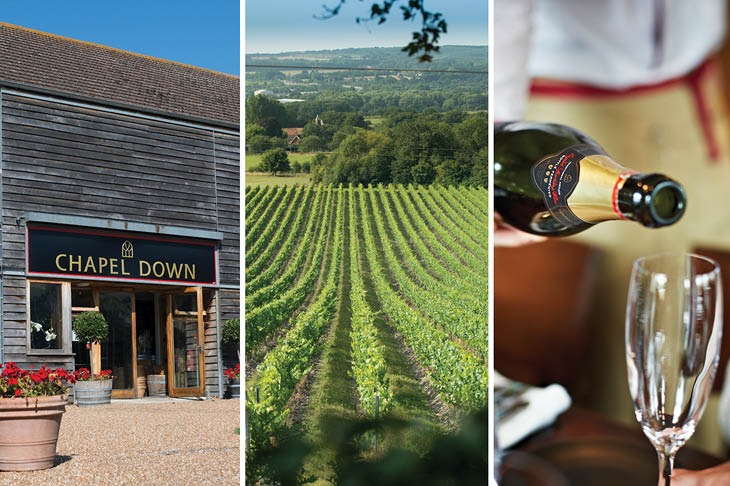Mark Harvey, Chapel Down’s managing director of wines, was in great form last week at our Spectator Winemaker’s Lunch, held as usual in our boardroom. And I must add that Mark’s wines were in equally tiptop shape.
With vineyards across Kent and a winery near Tenterden, Chapel Down is well-known as the largest producer of fine English wine. Although most of us around the table had enjoyed Chapel Down’s wares before, the one or two guests who hadn’t were taken aback by the wines’ quality, style and, well, sheer panache.
We started with the 2011 Three Graces, a fabulous fizz blended from Chardonnay, Pinot Noir and Pinot Meunier (the said three graces) and aged on the lees for four years. Crisp, clean and refreshing, it has delicious notes of nuts and toasty brioche with ripe, white stone fruit on the finish. The bottles were emptied in a flash, with guests begging for more.
With our starter of Forman & Field dill-cured gravadlax and sundried tomato and rocket salad we had the 2013 Kit’s Coty Blanc de Blancs (sparkling) and the 2014 Kit’s Coty Chardonnay (still), side by side. Both wines come from an exceptional south-facing single vineyard set high on the North Downs. The champagne-method fizz is of very fine quality. Aged for three years on the lees, it’s full of green and baked apple flavours and has a toasty, slightly honeyed finish. As for the Chardonnay, it’s without question the best still English wine I (or apparently any of our guests) have tasted. It’s mouth-fillingly fine with rounded, supple peach-like fruit and an ever so slightly toasty, vanilla finish thanks to nine months in French oak. If you like serious white Burgundy or Chablis, you’ll love this.
With a main course of asparagus, flamiche lorraine, charcuterie, crayfish and avocado cocktail, potato and roasted artichoke salad and mixed leaves we had Chapel Down’s 2016 English Rosé, a delectable pinkers blended from Pinot Noir (mainly) and several other varieties grown in Kent, Sussex and Essex. It went down a storm and everyone remarked upon its delicate rose petal aromas and long succulent finish. This was paired with Chapel Down’s 2014 Pinot Noir, which surprised us all with its sophistication and mellow, almost smoky, style. I’d had previous vintages of this and found them to be a bit thin and weedy; this was anything but, boasting delicious plummy fruit and soft, smooth finish. They seem finally to have cracked it. It’s true that it’s more akin to an Alsatian or German Pinot Noir than a Burgundian one but there’s nowt wrong with that. We all loved it.
The final wine was the Chapel Down 2013 Nectar Late Harvest, a blend of Reichensteiner, Schönburger, Seigerrebe and Bacchus. It’s light and ethereal rather than full-on rich and oily like a Sauternes. It’s delicately sweet and delightful with cheese (as we had it) or with strawberries and cream. It does perhaps lack a little weight, depth and body, but it’s a charming frivolity nonetheless and I reckon that at just 8 per cent vol it would work rather better as an aperitif spritz than as a pudding wine.
Finally, with coffee, we had the quite extraordinary Lamberhurst Fine & Rare 23 Year Old English Grape Brandy. I think it’s fair to say that it stopped every one of us in our tracks. It’s utterly stunning, produced for Chapel Down by that eccentric and brilliant distiller, Julian Temperley, he of the sublime Somerset Cider Brandy. It’s as fine a spirit as you’ll find outside Cognac, Gascony or Normandy, being full of rich, ripe fruit with apple notes, toffee, spice and caramel.
I’m proud to say that every bottle of wine was drained by our guests and so toothsome was the brandy that I had to resort to flicking the lights to remind everyone that our chairman was anxious to get his boardroom back sometime before close of play.
If you’ve had the wines and spirits of Chapel Down you will know and love them as I do. If you haven’t, you’ve a great treat in store. And for those readers unfortunate enough not to be at our lunch, Mark Harvey has asked that we direct them to chapeldown.com, where these wines and many others might be purchased.
I’m more than happy to do so. Do try them, for if nothing else they prove beyond any doubt that England really does produce first-rate wines these days. Cheers!







Comments